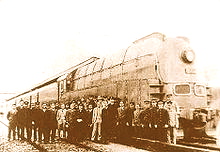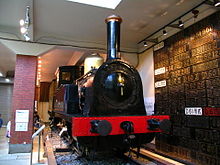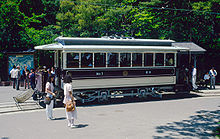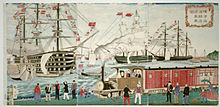Railroad Stations in Japan

JR Shizuoka Station
Shizuoka Prefecture (静岡県) is located in southeast of Japan. It is located on the Tokaido Sanyo Railway line and is serviced by both local JR lines and the Shinkansen (Bullet Train). Although not all bullet trains stop here, most do. JR Shizuoka Station (JR 静岡駅) services both the regular JR lines and the bullet trains. Shizuoka city is where Tokugawa Ieyasu was born. Tokugawa Ieyasu was the greatest Samurai in Japanese history and had the title of “Shogun”. This official title “shogun” (supreme commander of the feudal government) was given to him by the emperor at that time. In 1605, Tokugawa Ieyasu handed over the position of “shogun” to his third son Hidetada and retired to Sumpu Castle located in his childhood home in Shizuoka City. Shizuoka city is also known as the stopping and starting place for many trekkers to the Mt. Fuji. You can see great views of Mt. Fuji (富士山) on the way to Shizuoka city from Tokyo.
Early stage
In Yokohama, 1874
The history of rail transport in Japan began in the late Edo period. There have been four main stages. (1) from 1872 with the first line from Tokyo to Yokohama, to 1906 at the end of the Russo-Japanese war; (2) from nationalisation in 1906-07 to the end of World War II in 1945; (3) from the postwar creation of the Japanese National Railways to 1987, (4) privatisation from 1987 to present, as JNR was split between six new railway operators for passengers and one for freight.
 No. 1, one of the earliest locomotives later type 150, was UK made
No. 1, one of the earliest locomotives later type 150, was UK made
Though rail transport had been known through Dutch traders in Dejima, Nagasaki and earlier, the impact of model railroads brought by foreigners such as Yevfimy Putyatin and Matthew Calbraith Perry was huge. The British also demonstrated a running steam locomotive in Nagasaki. Saga Domain, a Japanese feudal domain (han), made a working model and even planned to construct a line by themselves. Other bodies such as the Satsuma Domain and the Tokugawa shogunate also reviewed railway construction. But a real line in service did not come into reality before the Meiji Restoration.
 The Briton Edmund Morell, was the first Engineer-in-Chief of the governmental railway, and is respected as the father of Japanese railways
The Briton Edmund Morell, was the first Engineer-in-Chief of the governmental railway, and is respected as the father of Japanese railways
Just prior to the fall of the Shogunate, the Tokugawa regime issued a grant to the American diplomat Anton L. C. Portman to construct a line from Yokohama to Edo (soon to be renamed Tokyo). In 1868 Thomas Blake Glover, a Scottish merchant, was responsible for bringing the first steam railway locomotive called the “Iron Duke” to Japan which he demonstrated on an 8-mile track in the Ōura district of Nagasaki. The new government of Japan decided to build a railway using British financing and 300 British and European technical advisors who were civil engineers, general managers, locomotive builders and drivers. On September 12, 1872, the first railway, between Shimbashi (later Shiodome) andYokohama (present Sakuragichō) opened. (The date is in Tenpō calendar, October 14 in presentGregorian calendar). A one-way trip took 53 minutes in comparison to 40 minutes for a modern electric train. Service started with nine round-trips daily.
English engineer Edmund Morel (1841-1871) supervised construction of the first railway on Honshu during the last year of his life, American engineer Joseph U. Crowford (1842-1942) supervised construction of a coal mine railway on Hokkaidō in 1880, and German engineer Herrmann Rumschottel (1844-1918) supervised railway construction on Kyushu beginning in 1887. All three foreign engineers trained Japanese engineers to undertake future railway projects. Two men trained by Crowford later became presidents of Japan National Railways. A bronze bust of Morel in Yokohama, a bronze statue of Crowford in the Temiya Railway Memorial Museum, and a bust of Rumschottel in Hakata commemorate the contributions of foreign engineers to Japan’s railways.[5] The reason of rail gauge choice remains uncertain. It could be because 3 ft 6 in (1,067 mm), as opposed to standard gauge of4 ft 8 1⁄2 in (1,435 mm), was supposed to be cheaper, or because the first British agent, later whose contract was cancelled, ordered iron sleepers of the gauge. It seems likely Morel’s previous experience building Cape gauge railways in similar New Zealand terrain may have been a significant influence. Anyway the decision still affects Japanese railways today, as the narrow Cape gauge became the de facto standard.
Some politicians, such as Inoue Masaru, stated all the railway lines should be nationalized. However, the government was financially strained after the Satsuma Rebellion, making the expansion of the railway network terribly slow. Politicians then wanted to allow private companies to build railways. Consequently, Nippon Railway was founded. It was a private entity, but strongly effected the government’s construction projects. It expanded railway lines fairly quickly, completing the main line between Uenoand Aomori (present Tōhoku Main Line) in 1891. With the success of Nippon Railway, private companies were also founded. Sanyō Railway, Kyūshū Railway, Hokkaidō Colliery and Railway, Kansai Railway and Nippon Railway were called the “major five private railways” at the time. At the same time, the national railway did open its railway lines, including the current Tōkaidō Main Line in 1889, but most of its lines were subsidiary to major private lines. In 1892, the Imperial Diet promulgated the Railway Construction Act, which listed 33 railway routes that should be constructed by either the government or private entities.
Rail transport was introduced not only for inter-city, but also for intra-city transportation. The first horsecar line in Japan was built in Tokyo in 1882. The first tram was the Kyoto Electric Railway (京都電気鉄道 Kyōto Denki Tetsudō), which opened in 1895.
Also, some operators began to use EMUs, rather than locomotives, for inter-city transportation. Many such railway companies, modeled after interurbans in the United States, are the origins of the current private railway operators.
 A tramcar of ex-Kyoto Electric Railway, now operated in a field museum Meiji Mura
A tramcar of ex-Kyoto Electric Railway, now operated in a field museum Meiji Mura
- 1872 – Opening of Japan’s first railway between Shimbashi (Tokyo) and Yokohama
- 1881 – Foundation of Nippon Railway, Japan’s first private railway company
- 1882 – Opening of Horonai Railway, first railway in Hokkaidō
- 1888 – Opening of Iyo Railway, first railway in Shikoku
- 1889 – Opening of Kyūshū Railway, first railway in Kyūshū
- 1889 – Completion of the Tōkaidō Main Line
- 1892 – Promulgation of Railway Construction Act
- 1893 – Class 860 steam locomotive, first locomotive built in Japan
- 1895 – Opening of Japan’s first streetcar in Kyoto
Pre-war development
Locomotives for the early railways were usually built in the country of the designing engineer. The first railways on Honshu used locomotives built in the United Kingdom. Locomotives from the United States arrived in Hokkaidō in 1888 and locomotives from Germany arrived in Kyushu in 1889. Early British locomotives were often of the tank type while the earliest American locomotives were 2-6-0 and 4-4-0 types with separate tenders. German manufacturers produced a number of smaller tank type locomotives including some for narrow 762 millimetres (2 ft 6.0 in) gauge. Richard Trevithick‘s grandson Francis Henry Trevithick became locomotive superintendent for JNR in the late 19th century, and ordered locomotives from the United Kingdom including numerous 4-4-0 types. F.H. Trevithick’s brother Richard Francis Trevithick designed the first locomotive to be manufactured in Japan in 1893. Japanese manufacturers initially depended heavily on imported locomotive parts. JNR ceased importing locomotives in 1912. Thereafter, with the exception of a few experimental locomotives manufactured by Orenstein & Koppel or American Locomotive Company, production locomotives were JNR designs built by Japanese manufacturers.
 D51, debuted in 1936, is the most mass-produced steam locomotive in Japan with 1,115 units.
D51, debuted in 1936, is the most mass-produced steam locomotive in Japan with 1,115 units.
Private railway companies were the major players in the early stages. However, after theFirst Sino-Japanese War and the Russo-Japanese War, the government planned to directly control the unified railway network for strategic purposes. In 1906, Railway Nationalization Act was promulgated, nationalizing many trunk railway lines. From this time, the national railway became the major Japanese railway network.
However, having used its money for nationalizing, the government didn’t have enough money to further expand the network to the countryside. They passed the Light Railway Act, encouraging smaller private operators to build light railways (軽便鉄道 keiben tetsudō).
Larger private railway operators, on the other hand, further developed their business modeled after interurbans. Hanshin Express Electric Railway (the current Hankyu Railway) built its own department store connected to its terminus; the management model still used today. Unlike interurban operators in United States that suffered from motorization as early as 1910s, Japanese counterparts didn’t experience the phenomenon as late as 1960s, giving them stable development and allowing their survival to the present.
As an intra-city rapid transit, the first subway in the East (the current Tokyo Metro Ginza Line) opened in 1927. The first trolleybus in the nation appeared in 1928.
In the territories of the Japanese Empire at the time, railways in Korea, Taiwan, andSakhalin were built by the Japanese. In Manchukuo, a nation in the current Northeast China virtually controlled by Japanese, South Manchuria Railway operated its railway network.
One of achievements in this period in railway technology was the conversion of all the link and pin couplers of locomotives and cars on the national network to automatic couplers. This work took place in July 1925 (in Honshū and Kyūshū) after considerable preparation. On April 1, 1930, the Ministry of Railways adopted the metric system, replacing British Imperial system, for the measuring of railways.
- 1895 – Japan’s acquisition of railway in Taiwan
- 1899 – Opening of Keijin Railway, first railway in Korea
- 1906 – Opening of first railway in Karafuto
- 1906 – Foundation of South Manchuria Railway
- 1906–1907 – Nationalization of 17 private railways
- 1910 – Promulgation of Light Railway Act
- 1914 – Opening of Tokyo Station
- 1925 – Introduction of automatic couplers to national network
- 1925 – Inauguration of the Yamanote Loop Line
- 1927 – Opening of Tokyo subway, the first subway in the East
- 1930 – Adoption of metric system
Wartime situation
After the start of the Second Sino-Japanese War and the Pacific War (World War II), the nation, including its railways, went under the military control. In 1938, the government decided to unify private railways into regional blocks, making larger companies such as Tokyo Kyuko Electric Railway (called Great Tōkyū in comparison with postwar Tōkyū) or Kinki Nippon Railway.
Also in this period, there was a second wave of railway nationalization. Twenty-two railway companies were forcibly acquired by the government in 1943 and 1944. Unlike the first wave in 1906–1907 that integrated trunk lines into the governmental control, the second wave mainly targeted railways with industrial value. Those acquired lines include the Tsurumi Line, the Hanwa Line and the Iida Line.
On October 11, 1942, the Ministry of Railways adopted the 24-hour clock system for timekeeping of trains following the use in the military.
From 1943, the national railway reduced its (civilian) passenger service, putting priority for military transportation. In 1944, it abolished all the limited express trains, first class cars, dining cars, and sleeping cars. Under the Ordinance for Collection of Metals (金属類回収令 Kinzokurui Kaishū Rei?, Imperial Ordinance No. 835 of 1941), some railway operators were forced to remove one track from double track lines and others were even forced to discontinue their business in order to satisfy the military demand for steel with the rails removed from tracks.
On January 29, 1940, a train fire at Ajikawaguchi Station on the Nishinari Line resulted in 189 deaths. This is the deadliest rail accident in the history of Japan (although the death toll of another accident on the Hachikō Line in 1945 was arguably underestimated and might exceed this).
The war, especially strategic bombings by United States, damaged Japanese railways heavily. The worst case was that inOkinawa, which completely lost its rail transport until the opening of Yui Rail in 2003. In most cases, however, railways at least resumed their operations fairly quickly. Some lines of the national railway resumed right after the day of Tokyo bombing. Sanyō Main Line resumed two days after the atomic bombing in Hiroshima, while Hiroshima Electric Railway resumed three days after.
- 1942 – Adoption of 24-hour clock system
- 1942 – Opening of Kanmon Tunnel connecting Honshū and Kyūshū
- 1945 – End of World War II; railways were severely damaged
http://en.wikipedia.org/wiki/History_of_rail_transport_in_Japan





